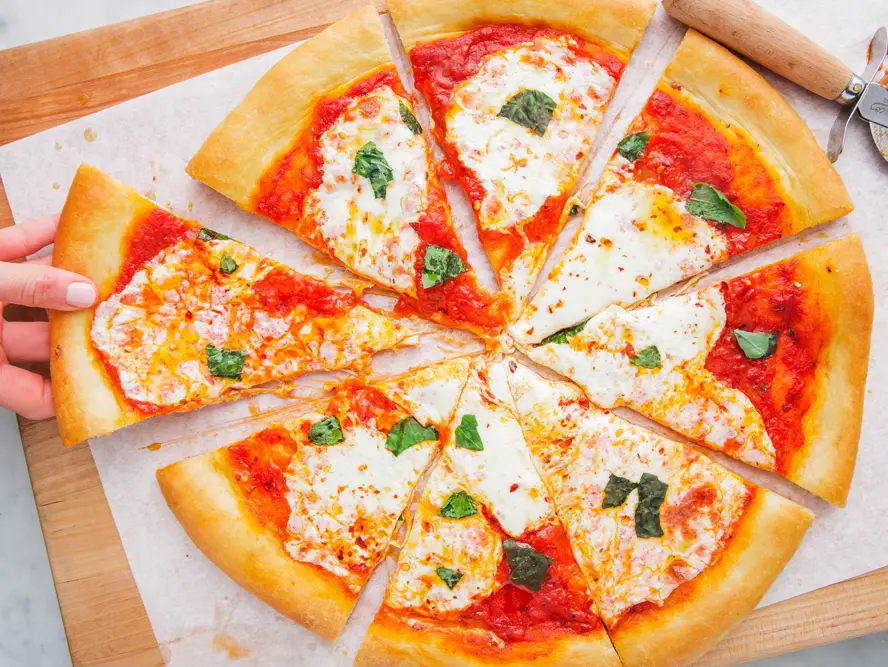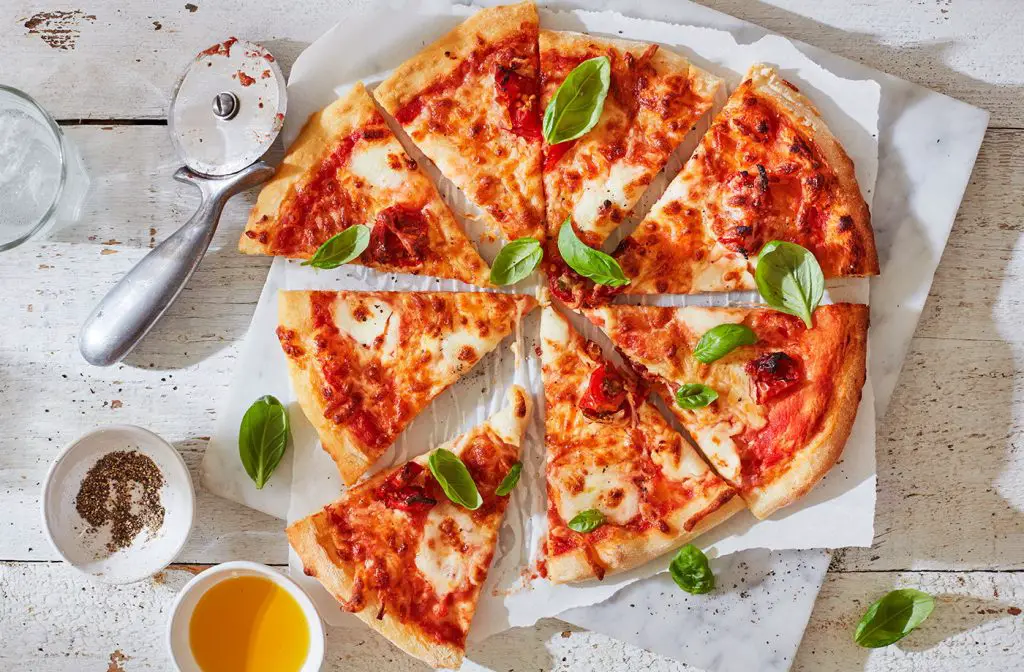Homemade pizza is a classic dish that many people enjoy. It’s easy to make and customizable, which makes it a favorite for dinner parties and family gatherings alike. But how many calories are in homemade pizza? Depending on the ingredients used, the calorie count can vary quite a bit. In this article, we’ll explore the average number of calories in homemade pizza as wellas some tips to reduce the calorie content.
Homemade Pizza Calories and Nutritional Information:

A single slice of homemade pizza can contain anywhere from 250-400 calories. This range depends on the size of the slice, as well as the toppings used. Additional items like meats or cheeses can add more calories to each serving. On average, a single slice will contain about 300 calories.
When it comes to nutritional content, there areseveral components that make up the calorie count of homemade pizza. It usually contains a combination of carbohydrates, fat and protein, as well as vitamins and minerals. A single slice can provide anywhere from 10-30 grams of carbohydrates, 4-10 grams of fat and 6-12 grams of protein. The amount of sodium in each slice will depend on the toppings used;
For those who are looking to reduce the calorie count of their homemade pizza, there are several tips that can be followed. For starters, using a thinner crust will help lower the calories in each slice. Additionally, opting for leaner meats like turkey or chicken and adding more vegetables can also reduce the calorie content. Making homemade pizzas with lighter toppings like fresh herbs orseasonings is another way to cut down on the calories and fat. Finally, using reduced-fat cheese or low-fat mozzarella will help lower the overall calorie content of your pizza.
Overall, homemade pizza can be a delicious and healthy treat when prepared correctly. With so many toppings and combinations available, there are plenty of options for making a tasty mealthat is both delicious and nutritious. By following a few simple tips, it’s possible to enjoy homemade pizza while keeping the calorie count low. With a little bit of creativity, you can create a meal that everyone will enjoy without sacrificing taste or nutrition.
How to calculate the calories in a homemade pizza?
Calculating the calories in homemade pizza is relatively easy. Start by measuring each ingredient used, then use a calorie counting app or website to calculate the total number of calories. After that, divide the total amount by the number of slices to get the calorie count per slice. This method works best for pizzas prepared with basic toppings such as cheese and vegetables.
For more complex pizzas, such as those with multiple meats or cheeses, it may be better to calculate the calories per topping and add them together. This will help you get an accurate estimate of the total calorie count for each slice of pizza. Remember that all ingredients should be weighed before calculating the calorie content.
Does homemade pizza have less calories?
The answer to this question depends on the ingredients used and how the pizza is prepared. On average, homemade pizza will have less calories than store-bought varieties due to the lack of preservatives and added sugar. Additionally, opting for leaner meats and vegetables, as well as lighter toppings can help reduce the calorie count of your homemade pizza. With a fewsimple tweaks, you can enjoy pizza without compromising nutrition or flavor.
How many calories in a 10 inch homemade pizza?
A 10 inch homemade pizza will contain about 750-1000 calories, depending on the ingredients used. This can vary significantly based on the size of slice and items included. To reduce the calorie count of your pizza, opt for thin crusts and lighter toppings such as fresh herbs or reduced-fat cheese. Additionally, add more vegetables for added nutrition and flavor.
How many calories are in a homemade Italian pizza?
A single slice of homemade Italian pizza typically contains around 250-400 calories. This will depend on the size of the slice as well as the toppings used. Additional items like meats and cheese can add more calories to each portion. To cut down on calories, opt for thin crusts and lighter toppings such as fresh herbs or reduced-fat cheese. Additionally,add more vegetables for added nutrition and flavor.
How many calories in homemade pizza dough?
Homemade pizza dough contains about 150 calories per 1/6 of a 9 inch crust. This can vary slightly depending on the type of flour used and other ingredients added to the dough, such as oil or sugar. For those looking to lower the calorie count of their pizza, opt for thin crusts and lighter toppings. Additionally, adding more vegetables willhelp reduce the overall calorie content of your homemade pizza. With a little bit of creativity, you can create a delicious and nutritious meal that everyone will enjoy.

Can I make my own low-calorie pizza?
Yes! It is possible to make a low-calorie pizza at home with some simple tips and tricks. For starters, opt for thin crusts and lighter toppings such as herbs or reduced-fat cheese. Additionally, load up on vegetables for added nutrition and flavor. Using leaner meats such as turkey or chicken will also help reduce the overall calorie count of your pizza. Finally, using whole wheat flour instead of white can help make a healthier crust option. With these tips, it’s easy to enjoy homemade pizzawithout sacrificing taste or nutrition.
Can I make my own gluten-free pizza?
Yes! Making a homemade gluten-free pizza is possible with some adjustments to the dough. Instead of using all purpose flour, opt for a gluten free alternative such as almond or coconut flour. Additionally, use xanthan gum as a binder and add olive oil for moisture tocreate the perfect dough. With a few simple tweaks, you can create a delicious gluten-free pizza that everyone will enjoy.
Can I make my own vegan pizza?
Yes! Making a vegan pizza is possible with some minor adjustments to your ingredients list. Instead of using animal products such as cheese and meat, opt for plant-based alternatives like tofu or tempeh. Additionally, you can use vegan cheese substitutes or nutritional yeast for added flavor and nutrition. With a few simple swaps, it’s easy to create a delicious and nutritious vegan pizza that everyone will love.
Can I make my own low-carb pizza?
Yes! Making a low-carb pizza is possible with some minor adjustments to the crust. Instead of usingtraditional flour, opt for an alternative such as almond flour or coconut flour. Additionally, use xanthan gum as a binder and add olive oil for moisture to create the perfect dough. With these minor adjustments, you cancreate a delicious low-carb pizza that everyone will enjoy.
Conclusion
In conclusion, pizza can be a nutritious and delicious meal with some simple adjustments. By using leaner meats, lighter toppings, and more vegetables, it’s possible to create a homemade pizza that is both tasty and healthy. Additionally, alternative crusts such as almond flour or coconut flour can help make the pizza even healthier. With these tips in mind, you can enjoyhomemade pizza without compromising nutrition or flavor.
In addition to being a healthier option, making your own pizza can also be more budget-friendly than buying pre-made pizzas from the store. With some basic ingredients and a few simple tips, you can easily make delicious homemade pizza that everyone will enjoy.

William Lariviere is a chef and restaurateur with over 25 years of experience in the food industry. He is the owner and operator of Swartzsdeli.com, an online restaurant that specializes in gourmet sandwiches and salads, grill & smoke. He likes to share experience, food, recipes cooking knowledge as well as reviews about restaurant and kitchen products.
William’s goal is to provide his customers with healthy, delicious food that is also affordable and develop Swartzsdeli.com into a comprehensive information site specializing in cooking and cuisine to a new level to help reach a wide range of housewives and readers.








